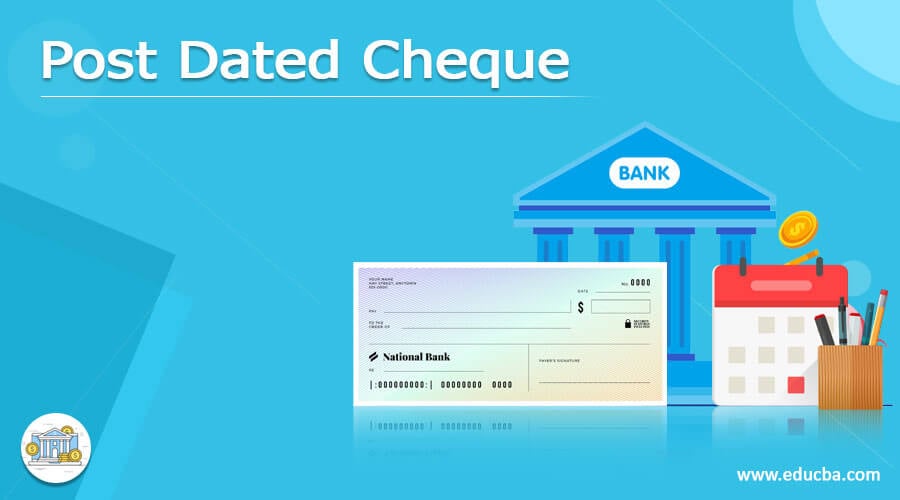Updated June 21, 2023

What is a Post Dated Cheque?
In banking parlance, the term “post-dated cheque” refers to a cheque written by the payer (drawer) for a future date. In simpler terms, a cheque is written with a future date beyond the date on which it was written. In this case, the drawer should always maintain enough funds in the account so that the cheque doesn’t get dishonored/bounced on the specific date mentioned in the cheque.
How does Post Dated Cheque work?
The drawer issues a cheque with a future date. So, there shouldn’t be any journal entries to record in the drawer’s books, i.e., there should be no reduction in cash until the specified date. Also, the recipient shouldn’t make any entry in their books, i.e., there shouldn’t be any increase in money until the selected date. So, the date mentioned in the cheque effectively postpones the recording of the underlying transaction. The drawer will capture the transaction accordingly on the specified date, reducing cash and payables recorded. At the same time, the recipient will book an increase in cash and a decrease in receivables.
Examples of Post Dated Cheque
Let us look at the following examples to understand the concept.
Example #1
Let us assume that XYZ Inc. received a cheque for $1,000 from a customer for an unpaid invoice on 15th December 2021. It was a post-dated cheque with a specified date of 15th January 2022. So, XYZ Inc. couldn’t record the cash receipt for the financial year ending 31st December 2021, nor could it reduce its associated accounts receivable in the books. Hence, the it did not impact XYZ Inc.’s financial statements for 31st December 2021.
Example #2
Let us assume that ABC Inc. owes a supplier $5,000 for purchases made on 30th April 2021, which was 31 days back. Since ABC Inc. doesn’t have adequate cash available to make the payment to the supplier, the company offers to provide two $2,500 cheques: one dated 15th June 2021 and the other dated 15th July 2021.
On 31st May 2021, the supplier accepted the cheques and agreed to deposit them on the dates mentioned. On 15th June 2021, the supplier increased the cash by $2,500 by depositing the first post-dated cheque while reducing the accounts receivable by $2,500. On 15th July 2021, the supplier deposited the second post-dated cheque, repeating a similar transaction.
Why issue a Post Dated Cheque?
The drawer typically uses a post-dated cheque to postpone the payment to the recipient. In contrast, the recipient accepts such delayed payment because it represents a fixed date for the deposit, which eventually translates into revenue.
However, the payer utilizes it when they must hand over many post-dated cheques to cover future payments. The recipient agrees to such a payment arrangement because it enhances the payment odds. Furthermore, businesses utilize it as a credit risk mitigation in the event of installment payments.
Post Dated Cheque Validity
The validity of the cheque remains for three months from the date of issuance, regardless of the number of days between the two dates. For example, if someone issues the cheque on January 15th, 2021, it will be valid until March 14th, 2021.
Rules for Post Dated Cheque
- Fraud is Not Allowed: Issuing a post-dated cheque without sufficient funds is illegal.
- Not a Written Agreement: In countries like US and UK, the payee can deposit the cheque at any point in time before the specified date unless and until the drawer mentions to the bank that the post-dated cheque can’t be encashed before the specified date. However, it is not applicable in countries like India and Australia, where banks can’t encash the cheque before the selected date.
- Communicate with the Bank: A future date mentioned in a cheque means or guarantees nothing. The drawer must provide precise instructions to the bank regarding the required actions and their execution. Different banks have different rules regarding monitoring and preventing premature payments of these post-dated cheques.
Key Takeaways
Some of the key takeaways of the article are:
- The drawer issues a cheque to a recipient to be encashed on a particular date in the future.
- Before the date mentioned in the cheque, there shouldn’t be any journal entry to record in the accounting books of both drawer and recipient.
- Like any ordinary cheques, post-dated cheques have a validity of 3 months from the date of issuance.
- Issuing a post-dated cheque without sufficient funds is illegal.
Conclusion
Post-dated cheques are used as short-term credit or loans and help businesses expand. It allows running business operations without stopping for lack of funds. Drawers also use it to avail products and services before paying for them upfront. Overall, it is a powerful financial instrument if used wisely and strategically.
Recommended Articles
This is a guide to Post Dated cheques. Here we also discuss the definition, working, examples, issues, validity, and rules for Post Dated cheques. You may also have a look at the following articles to learn more –

